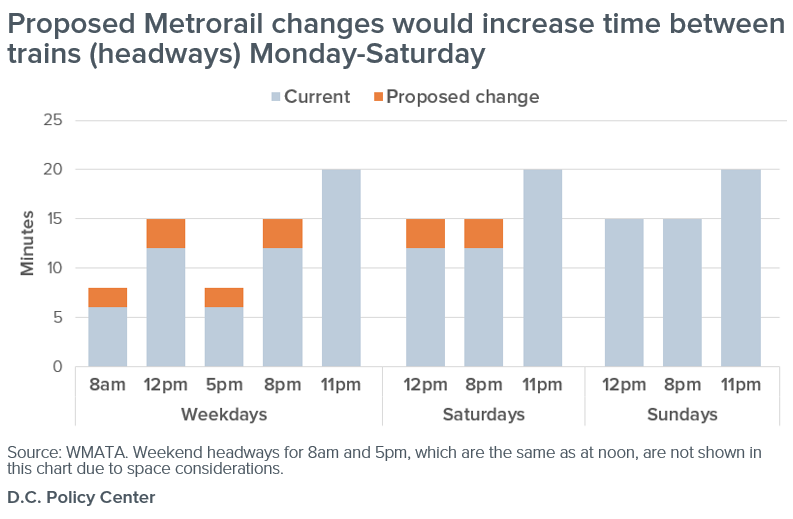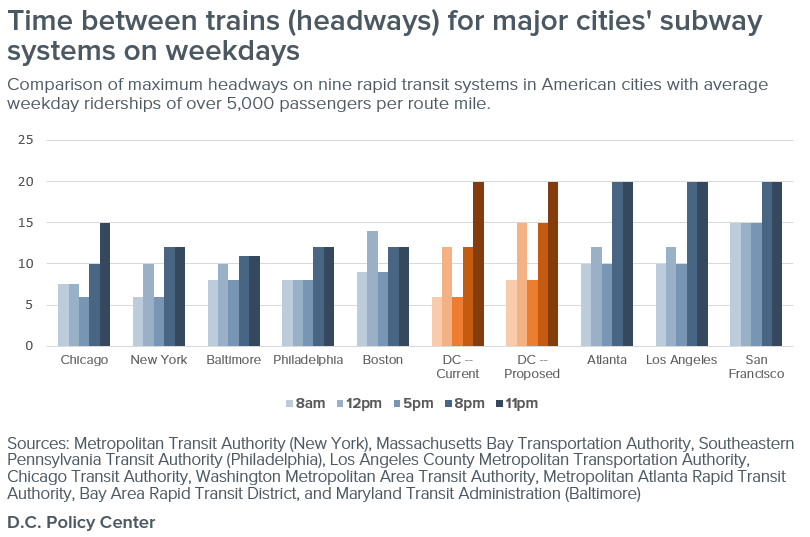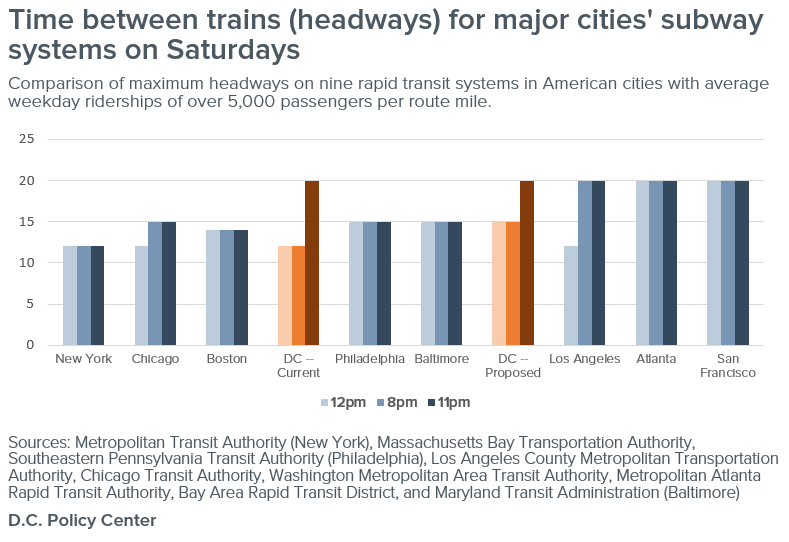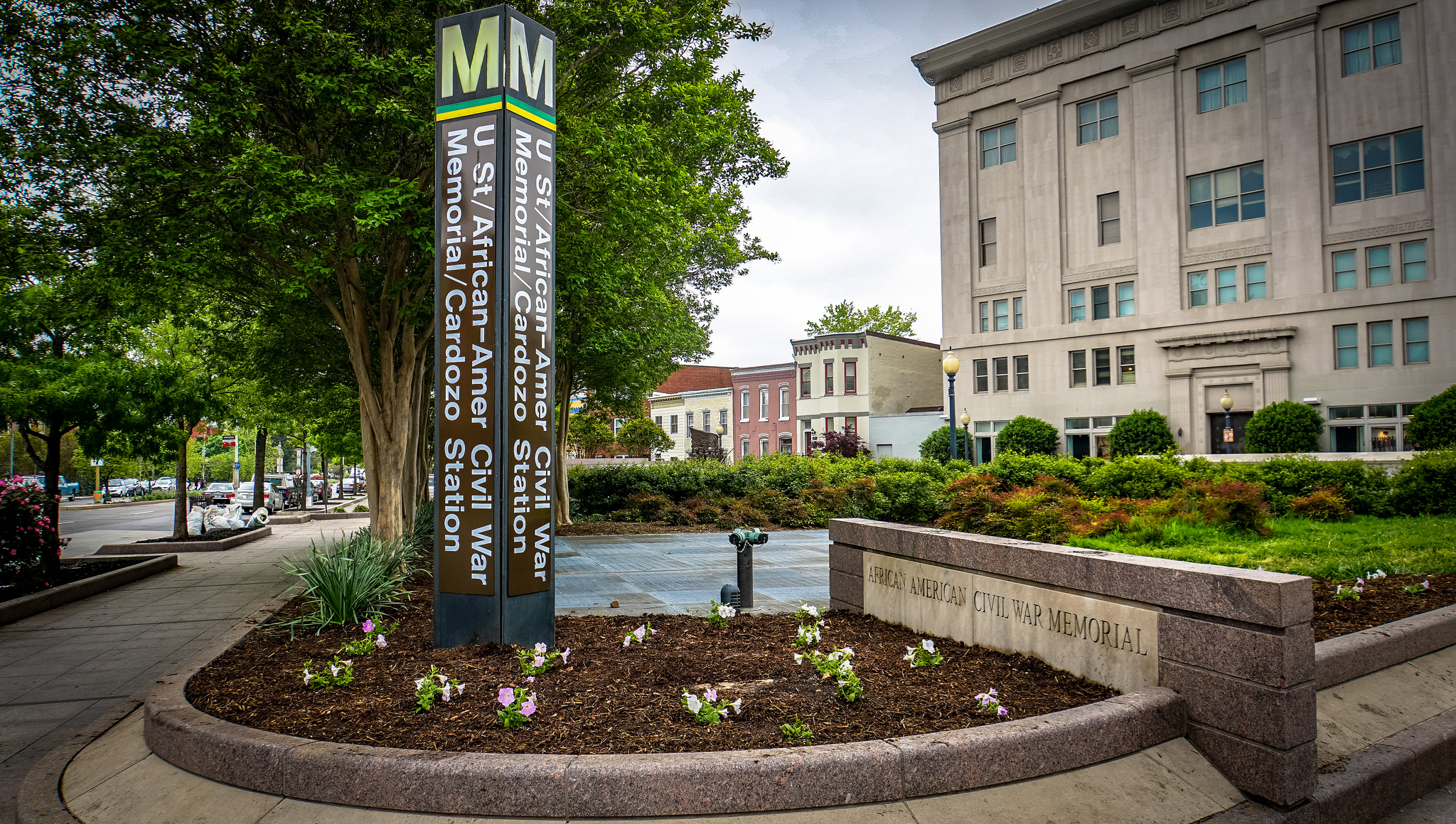Along with fare increases, WMATA’s proposed fiscal 2018 budget includes cuts to Metrorail and Metrobus service as a way to close the authority’s budget gap. Reducing the total number of vehicle trips per day is an effective way to cut operating costs for a transit system. However, doing so also reduces the system’s utility to riders, and encourages them to switch to other transportation options. This can push a transit system into a “death spiral,” where reduced service and increased fares lead to a decrease in ridership, which contributes to budget deficits, leading in turn to further service cuts and fare hikes. There are already concerns that Metrorail has entered such a spiral, given that ridership has fallen 20 percent from its peak in 2009.
SafeTrack, the accelerated-maintenance project that WMATA began this spring, was necessary to deal with the system’s maintenance backlog, but has already led to service reductions. Evening hours have been cut significantly, particularly on weekends, to allow more time for maintenance, and sections of the system have been single-tracked or closed for extended periods—sometimes over a month.
WMATA is also considering plans to reduce service by increasing the amount of time between two trains on the same route, known as “headways.” These changes would increase headways on weekdays, and further increase headways on Saturdays to bring them in line with Sunday schedules.

Increasing headways is a common way to moderately reduce transit costs without a major impact on riders. However, in the context of other service cuts, this may not be a wise option. Users of rapid transit systems like Metro do not generally plan their trips around a fixed schedule. Instead, the usefulness of these systems is in part due to the fact that riders can simply walk up to a station and expect to catch a train with no further planning. A longer wait for the next train when one walks into the station—or for a train one is transferring to—means a longer trip. Furthermore, various studies have shown that travelers do not perceive all travel time equally: In general, passengers are less willing to spend time waiting for a bus or train than to spend an equivalent amount of time aboard a moving bus or train.
In operating any rapid transit network, the trade-off between providing short headways so that passengers to not have an excessive wait for the next train and lengthening headways to cut costs and avoid running nearly-empty trains will depend on factors specific to that network. However, it is useful to consider the choices that have been made by a variety of different American rapid transit networks.
Metrorail’s rush-hour frequencies are high compared to other systems
The graphs below compare Metrorail’s current and proposed headways to those in the five other American cities with rapid transit networks with average weekday riderships of at least 5,000 riders per route mile.

Since weekday ridership is heavily peaked at rush hour, most rapid transit systems run different headways during the morning and evening rush hours, at mid-day, in the early evening, and later at night, though the exact boundaries they pick between these periods vary. Multi-line systems also often run different frequencies on different lines, and systems with branches will generally have more frequent trains on downtown segments where multiple lines run on the same track. For comparison, I have chosen to plot the longest headways that a system uses for each time period.
By this standard, Metrorail currently does quite well in terms of rush hour service. Its rush hour headways are among the shortest in the country and much shorter than the ten-minute headways that Los Angeles’s Metro run at rush hour. The proposed increases in the fiscal 2018 budget would still only push it into the middle of this range.
Proposed cuts will hurt evening and weekend service
It is non-rush-hour service where Metrorail’s service cuts will hurt the most. The proposed cuts will raise mid-day and early-evening headways to fifteen minutes, longer than all five rapid transit systems with similar or higher riderships per mile to Metrorail. Later-evening headways are already 20 minutes, far higher than the late evening headways in New York, Boston, Philadelphia, and Chicago.

Weekend rapid transit service does not generally have rush-hour peaks, and can be similar throughout the day. Here, again, Metrorail is roughly in the middle of the road, though it is notable that its late-evening service already has twenty-minute headways, significantly higher than those in New York, Boston, Philadelphia, and Chicago.
Why off-peak frequency is important
The loss of off-peak ridership that is likely to result from these service reductions may seem less important from a purely budgetary perspective: Roughly two-thirds of Metrorail’s riders ride at rush hour, and the longer trips from the suburbs that pay maximum fares are particularly likely to occur at this time. However, maintaining mid-day, evening, and weekend ridership is essential to Metrorail’s and the region’s future.
The boom in dense, walkable, transit-accessible development in the D.C. area (and nationally is dependent on new residents’ belief that transit will provide for all of their transportation needs, not merely their commute to work. These non-work trips are a particularly large component of ridership during off-peak times, and comprise nearly 20 percent of Metrorail’s total ridership. Meanwhile, if D.C. residents conclude that they cannot rely on Metrorail outside of rush hour and either purchase cars or use ride-hailing services like Uber or Lyft for their non-commute trips, it will increase the number of cars on the road—already a problem in a city with some of the country’s worst congestion.
Transit-dependent riders—including low-income riders, those without cars, older adults, and those living with a disability—make up a sizable fraction of Metro’s ridership, and are more likely to rely on Metro for off-peak service. In particular, low-income populations are both likely to be transit-dependent and to have work schedules that require commutes outside the normal rush hours. These populations are also less able to afford ride-sharing or new car purchases as an alternative to infrequent transit service.
Furthermore, even commuters from the outer suburbs benefit from higher off-peak. If Metro headways outside of rush hour are too long, these workers will choose to drive to work on days they expect to work late, or to do shopping or eating out after dinner, adding congestion to the roads at rush hour.
